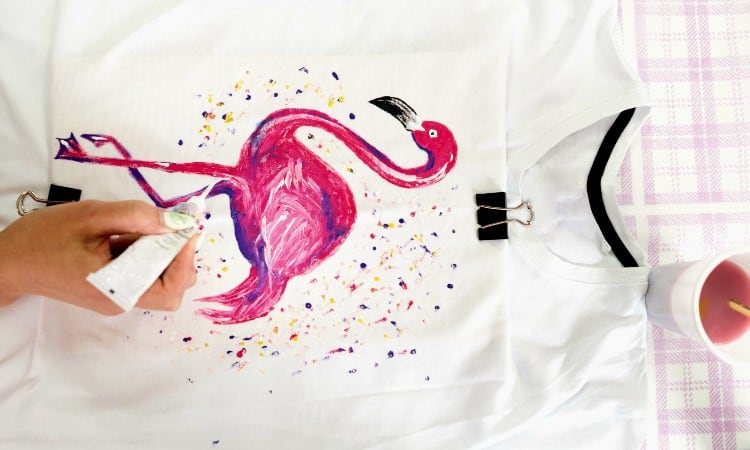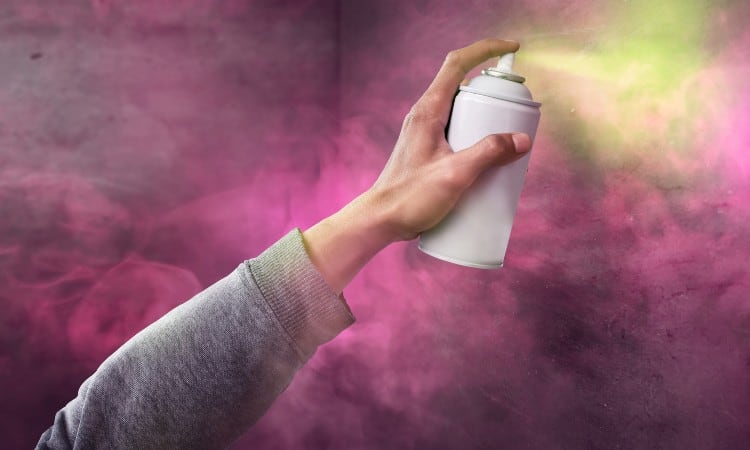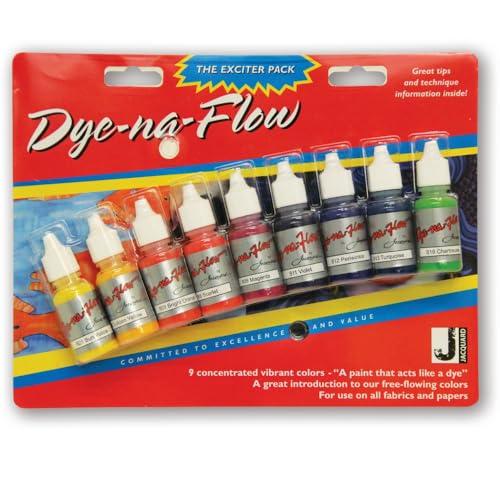Painting fabric is fun for everyone, from textile artists to preschool teachers! Before diving into this creative project, though, you probably want to do a bit of research to make sure you use the right kind of paint for each type of fabric. Whether you plan to freshen up a thrift store armchair, elaborately stencil your cosplay costume, or decorate t-shirts at your child’s birthday party, chances are you will need to know how to paint polyester!
The most popular and permanent paint for polyester is acrylic paint mixed with a fabric medium that allows the paint to adhere smoothly without cracking. Textile artists also find success using certain types of spray paints and synthetic dyes. Artists use brushes, stencils, sponges, and spray paint to paint on polyester.
In this article, you will find out what kind of paint works best on polyester, tips for painting special projects like upholstery and clothing, and general guidelines for working with fabric paints.

Can You Paint Polyester Fabric?
You can easily paint polyester fabric using many different techniques. That said, you will want to make sure the paint you use can stick to synthetic material.
Some paints will not adhere to polyester’s plastic fibers. Oil paints usually do not work well, but acrylics do bond well since they are also made of plastic.
You might be surprised by how much of your household items and clothing contain a significant amount of polyester. Pretty much every big-name store and brand sells items made from polyester these days. This is because it costs so much less to make synthetic fabrics than it does to harvest, process, and manufacture natural fabrics.
Advanced textile sciences can produce polyester fabric that closely resembles many other kinds of cloth as well. If you take a closer look at the garment labels in your closet, you might find that items can look like they are made out of velvet, fur, silk, or cotton knits, when actually, they are made out of polyester!
Anyone interested in textile arts will likely need to know how to paint polyester because this fabric is so prevalent today.
First, it helps if you understand a tiny bit about how this fabric is made.
Unlike cotton or wool, which begin life as natural fibers, polyester comes from a by-product of petroleum. Factories use a scientific process called polymerization polymers. Polymers are long, strong chains of molecules linked together.
At this point, the polyester looks like plastic soup! The factory then uses long nozzles to eventually form the plastic into fibers.
The fibers become fabric in many different ways. Some factories produce woven polyester, such as the printed sheer curtains you may have in your bathroom. Others manufacture poly blends or poly knits.
The result can look as wildly different as velvet and microfiber. However, every type of polyester fabric begins its life as a type of plastic built from long, regular strands of molecules.
Because of its plastic fibers, polyester does not absorb water and resists staining. Only disperse dyes will color synthetic fabric, and not all paints will adhere to its plastic fibers.
Can You Use Fabric Paint on Polyester?
Many fabric paints are acrylic polymers, and some of them adhere well to polyester. That said, you should always read the label or product description before you purchase to find out what type of surface it works on.
Sometimes fabric paints will stick to polyester, but only after you wash the material, or only if you heat-set the color after application.
The term “fabric paint” usually refers to the thick, three-dimensional puffy paint you squeeze out of a little tube directly onto the fabric. You can also buy thinner fabric paint to apply with a brush or use fabric markers for detailed work.
Unless you especially want the raised design of puffy fabric paint, you can save yourself some money and find a wider range of colors available to you by using regular acrylics mixed with a fabric medium. This creates a thin, smooth paint perfect for spreading over the cloth.
In general, you will want to stay away from anything oil-based. These paints will dry stiffly and will probably crack and peel away from the fabric.
What Kind of Paint Can You Use on Polyester?
Acrylics are the most reliable, popular choice of paint for a polyester surface. Many traditional fabric paints and fabric markers will also work. Some brands like Jacquard even offer unique products designed specifically for use on synthetic fabric.
Tulip Fabric Paint
 Tulip fabric paint works on poly blends such as polycotton. However, it is not specifically recommended by the manufacturer for 100% polyester.
Tulip fabric paint works on poly blends such as polycotton. However, it is not specifically recommended by the manufacturer for 100% polyester.
Some artists use Tulip products on 100% polyester without any negative side effects. Others note that the puffy paint tends to crack and can peel away from the synthetic material.
Tulip is probably one of the best-known brands in the world of fabric art. The brand offers both the familiar dimensional paint and a thinner version called soft paint.
Tulip products may not be the right choice for refreshing upholstery or creating a complex work of art. However, you may find this brand an affordable and fun product to use for children’s projects. It also works well for simple crafts like stamping colored butterflies onto your dining room curtains.
Tulip fabric paint dries permanently and is machine washable.
Acrylic Paints
 Acrylic fabric paint is far-and-away the most popular choice for painting on polyester. This is great news for any enthusiastic textile artist. Pretty much every crafting store carries a huge array of acrylic paints in every shade imaginable!
Acrylic fabric paint is far-and-away the most popular choice for painting on polyester. This is great news for any enthusiastic textile artist. Pretty much every crafting store carries a huge array of acrylic paints in every shade imaginable!
Plus, acrylics tend to cost less than official fabric paints–you can buy a good range of colors at Walmart for just fifty cents a bottle!
Acrylics are polymers derived from petroleum. In other words, this paint is a liquid form of plastic with a few other chemicals thrown in and microscopic color pigments suspended within the plastic.
One of the neat things about acrylics is that they dissolve in water while still wet. This makes cleaning up and correcting errors super easy! Once the paint dries, it is no longer water-soluble and usually sets permanently.
Some acrylics require special techniques such as pre-washing the material, thinning the paint with a fabric medium, and heat-setting the material after completing your project. If you follow these steps, though, your design will set permanently in the fabric.
Jacquard Fabric Paint
 Jacquard Dye-Na-Flowworks on both natural and synthetic fabrics. This unique colorant creates all kinds of very cool art. Some artists use this dye-like substance to create fabric art that looks like stained glass or jewels. The transparent, jewel-toned coloring gives this paint a special quality.
Jacquard Dye-Na-Flowworks on both natural and synthetic fabrics. This unique colorant creates all kinds of very cool art. Some artists use this dye-like substance to create fabric art that looks like stained glass or jewels. The transparent, jewel-toned coloring gives this paint a special quality.
According to Jacquard, their product operates more like a traditional dye than fabric paint. It sinks deep into the pores and fibers of the cloth as you work. You can apply Dye-Na-Flow using a brush, sponging or stamping, or even using an airbrush!
Like some acrylics, you have to set the color with heat to make it permanent and washable. This can be tricky on polyester, which melts under very high heat, so be sure to read the product instructions. Usually, the lowest setting on your iron or moderate heat in the dryer will not damage the material.
How to Paint Polyester Fabric
You can use many different methods to paint polyester fabric, depending on how you like to apply paint and what kind of surface you need to color.
Creative home decorators use tape and acrylics to create stripes on polyester drapes. Or they use a sponge cut into a flower shape to dapple an armchair with multi-colored flowers.
Artists who prefer to wear their art brush delicate flowers around the collar of a t-shirt or airbrush band logos onto the back of a sweatshirt.
Here are some helpful tips to get you started!
Helpful Tips
Whether you plan to paint an armchair or a t-shirt, though, you should consider a couple of key steps before you begin.
First, if at all possible, you should prewash your fabric. This is important because manufacturers often treat polyester cloth with sealants or coatings. These chemicals make the cloth extra water-resistant, fire-resistant, and/or mildew resistant.
Washing your fabric surface also ensures that you won’t have dirt, stains, or any other obstacles between your brush and the fabric.
Second, pick a paint that fits your project. If you want to stencil, a really thin paint might seep under the edges of the design and smear your image. On the other hand, if you plan to use an airbrush, you will need thin paint!
Along those lines, consider purchasing a fabric medium for acrylics. This special solution thins the paint without watering down the colors. Mixing in this thinner helps acrylics spread smoothly across the fabric and also helps prevent any cracking as the paint dries.
It’s also a good idea to select a cloth that has a tight weave. This helps prevent any bleeding between colors.
Your fabric item may have multiple layers, like the front and back of a t-shirt or the front and back of a shoulder bag. In this case, make sure you place a thick piece of cardboard between the layers while you work. This will make sure the colors don’t soak through to the wrong side!
As a final tip, you should read the instructions on the paint package to find out how long you need to let your artwork dry. Every product requires slightly different timing, and you don’t want to ruin your lovely project by rushing things!
Acrylic Paint on Polyester Fabric

Here are some hopefully helpful suggestions for applying acrylics to polyester fabric. Of course, there are as many different ways of applying paint to the fabric as there are different kinds of finished pieces of textile art! A lot of fabric art involves trying things out to see how it looks.
In general, though:
- Acrylics need shaking up before you open and use them. If you skip this step, you might find yourself working with a runny, water substance.
- Many artists recommend mixing one part fabric medium to two parts paint before you begin.
- Follow the pre-washing and preparation steps described earlier. You should also dampen the polyester fabric before applying acrylics. You can do this with a light misting from a clean spray bottle.
- Select your tools based on the result you want. For example, if you want to apply a repeated design across an entire tablecloth, you probably want to use a stamp instead of a brush. If you want to cover a broad area of fabric with a single color, you might want to consider spray paint.
- Some acrylics require heat-setting before washing. Before ironing your project, test the very tip of your iron on an unobtrusive part of the fabric to make sure the what will not scorch or damage the cloth. Make sure you use the lowest setting on your iron since polyester does not respond well to heat.
- Allow the finished work of art to dry for 24 hours before washing it.
- Finally, consider applying a sealant coat or spray for an item that may see hard use, such as a piece of furniture.
Painting Polyester with Spray Paint

These days, you can buy many kinds of fabric paint in spray format. You can also mix acrylics with a thinner and use them through your paint gun or airbrush gun to spray paint polyester.
Many artists also have luck using regular brand-name spray paint, such as Krylon. However, some people complain that these products can feel stiff and crackly after application.
Whichever method you choose, here are a few suggestions for spray painting polyester.
- If possible, test a tiny spritz of paint on a hidden part of your item before you begin. This way, you can see how the color looks before you commit yourself.
- Preparation is key. Make sure you tape off or cover with plastic any part of the object you do not want sprayed! For example, if you’re painting an armchair, you should wrap the chair legs in foil, plastic wrap, or tape to prevent any spatter from hitting them.
- In a similar vein, you can take your project outside if you don’t mind multi-colored grass. Otherwise, you should swathe your work area in plastic sheeting to make sure you don’t accidentally splatter your kitchen floor!
- Also, while working with any kind of spray, you should make sure you wear eye protection.
- On to the fun part! Once you begin, move the spray can up and down or across in smooth, repetitive sweeps. You don’t want to stop and start a lot since this results in blobs of color dripping down the fabric’s surface.
- It’s usually necessary to apply two or three smooth coats, allowing each to dry between applications.
- When you’re done, read the spray can to find out if you should finish the project with a sealant coat. Some paints suggest this, while others might react badly with the sealant.
How To Remove Paint From Polyester
You can use several different methods to get paint out of polyester, depending on whether the stain is wet or dry.
The easiest method works on still-wet stains. Simply dab at the stain with a cloth soaked in water and dish detergent and try to blot up the color. For solid surfaces, you should be able to wipe and scrub the stain away using warm water and dish detergent.
If that doesn’t work, or if your stain has already hardened, you can try turpentine or paint thinner. A note of warning, though: some experts claim that acetone and turpentine will not damage the polyester fabric. However, you should test a hidden area of the fabric first, just in case.
Make sure the thinner you use matches the kind of paint that made the stain. Some solutions are designed only to work with oil, latex, or acrylic paints, so choose accordingly.
Many paint thinners can damage your skin and eyes, so wear protection. Also, please dispose of the thinner safely, according to local guidelines!
To get the stain out, spread the stained fabric tightly across the rim of a small disposable cup or bowl. Then slowly pour the thinner through the fabric, so it pools into the bowl beneath.
Rinse the fabric in water and examine the stain to see if it is gone. If not, repeat the paint thinner process.
Finally, either hand wash the item with a bit of laundry detergent rubbed gently into the damp area or run it through a regular wash cycle.
How to Dye Polyester
Polyester does not accept dye as easily as many natural materials, but you can dye synthetic fabrics using special disperse dyes. These dyes use heat to imbue color into cloth fibers that will not absorb water.
Rit DyeMore is probably the most popular disperse dye easily available for home use.
When working with disperse dyes, you will need to have a large container you can place over a heat source, such as a kitchen stove.
- First, cover everything around your stove with plastic sheeting to protect from dye splatter.
- Wear protective gear such as thick rubber gloves to avoid burning yourself.
- Measure the amount of water and disperse the dye according to the package instructions.
- Next, bring the water in your pot to a boil and stir in the dye powder.
- Add your fabric item slowly to avoid splashing boiling dye all over yourself.
- You will need to boil the dye bath for a while. Follow the instructions on the package for specific timing, but this process usually takes at least thirty minutes.
- Carefully remove the dyed item using tongs, and rinse in warm water repeatedly. When the water begins to run clear, switch to rinsing in gradually cooler water.
- Lastly, either hand wash or run the item through a regular wash cycle, and then air dry!
Best Fabric Paint For Polyester
If you’re in a hurry and want a quick recommendation for an excellent starter kit, here are two great products you can use on polyester. As you now know, acrylics offer a lot of flexibility in the textile arts and remain the most popular choice for use on polyester. Jacquard’s Dye-Na-Flow set also offers an interesting and more dye-like coloring choice.
Apple Barrel Acrylic Craft Paint Set
 Apple Barrell sells well-respected acrylic paints perfect for all kinds of crafting at very affordable prices. This nice starter set includes 18 colors. Each bottle holds 2 fl oz of paint, and the set features all the basic colors featuring fun names such as Flag Red and Flame Yellow. These non-toxic paints apply to nearly all surfaces smoothly.
Apple Barrell sells well-respected acrylic paints perfect for all kinds of crafting at very affordable prices. This nice starter set includes 18 colors. Each bottle holds 2 fl oz of paint, and the set features all the basic colors featuring fun names such as Flag Red and Flame Yellow. These non-toxic paints apply to nearly all surfaces smoothly.
As part of the Plaid family of brands, Apple Barrel has been around for a long time. Artists use these paints to color 3D-printed plastic objects, canvas, and many different types of fabrics.
Jacquard Dye-Na-Flow
 Dye-Na-Flow works well on items like swimsuits and leotards. This paint is specially designed to work on all fabrics, including synthetics such as polyester and nylon. The set includes nine .5 oz bottles of concentrated color at an affordable price, though these specialized fabric paints cost more than the average tube of acrylics.
Dye-Na-Flow works well on items like swimsuits and leotards. This paint is specially designed to work on all fabrics, including synthetics such as polyester and nylon. The set includes nine .5 oz bottles of concentrated color at an affordable price, though these specialized fabric paints cost more than the average tube of acrylics.
The primary colors feature names like Periwinkle and Magenta. Artists recommend using these paints to the sponge, stamp, brush, or airbrush. The thin nature of these colorants does prevent use with stencils. However, according to the manufacturer, you can mix the paint with ¼ as much water to create a perfect tie-dyeing solution.
Conclusion
Most artists agree that acrylics mixed with a fabric medium provide a smooth and permanent way to paint polyester fabric. Other paints designed to work with synthetic fabrics, such as Jacquard’s Dye-Na-Flow, can also work well. You can apply paint to polyester fabric with stamps, sponges, spray guns, or the traditional brush!
Now that you’ve had a whirlwind tour of the world of fabric paints, are you ready to pull out your brushes, stamps, or sponges and get to work? If you’re planning a fabric paint project, leave a comment below to let us know what kind of paint you plan to use!

Caviar
Friday 25th of June 2021
Thanks! My Jacquard paints are in storage 🤦🏾♀️ However "medium" never explained for mixing with acrylic paints.